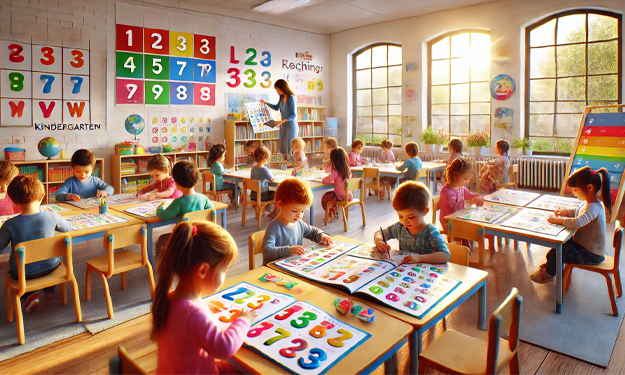Introduction
Kindergarten workbooks are important tools in early childhood education. These workbooks provide structured activities that help young children learn basic skills, such as counting, letter recognition, and simple problem-solving. Selecting the right workbook can significantly impact a child's learning and make education more enjoyable.
Choosing a suitable workbook is an important decision for parents. The right workbook not only engages children but also aligns with educational goals, ensuring a balanced approach to learning. This article will guide parents through understanding what makes a good kindergarten workbook, look at different types available, and share tips on how to incorporate them into daily routines. We will also touch upon the larger benefits of using educational books in tandem with workbooks to enhance a child's learning experience.
Research supports the significance of early education tools like workbooks, highlighting their role in child development. Let's explore what makes a kindergarten workbook effective and how it can aid your child's early educational journey.
Key Features of Kindergarten Workbooks
When selecting the best kindergarten workbook for your child, consider the following key features:
- Age Appropriateness: Workbooks should match a child's age and ability level. Look for age-specific content that challenges but doesn't overwhelm.
- Engaging Activities: Activities within the workbook should be fun and captivating to maintain a child's interest. Interactive exercises, like puzzles and coloring pages, are excellent for keeping kids engaged.
- Educational Alignment: Ensure the workbook aligns with educational standards or curricula. This alignment helps reinforce what children might learn in a kindergarten setting.
Some typical activities in kindergarten workbooks include:
- Tracing letters and numbers: Helps improve handwriting and number recognition.
- Simple math problems: Encourages early numeracy skills through addition and subtraction.
- Art and craft tasks: Promote creativity and hand-eye coordination.
These features and activities are not only fun but also foundational for effective learning. Studies on effective educational tools emphasize the importance of choosing workbooks with these characteristics to aid in child development. By focusing on these features, parents can select a workbook that supports their child's growth and eagerness to learn.

Types of Kindergarten Workbooks
When it comes to kindergarten workbooks, there are several types to consider. Understanding these can help parents choose the right one for their child's learning style and needs.
- Big Kindergarten Workbooks: These are comprehensive workbooks that cover a wide range of subjects, including math, reading, and writing. They are designed to provide a broad educational experience and are perfect for general learning.
- Subject-Specific Workbooks: Some workbooks focus on a single subject, like math or reading. These are great for reinforcing a particular area where a child might need extra practice or interest is high.
- Interactive Workbooks: These include activities that engage children in hands-on learning, such as puzzles and games. Interactive workbooks can make learning more enjoyable and hold a child's interest longer.
- Thematic Workbooks: These focus on specific themes, like animals or seasons, and integrate learning activities around a central topic. They're excellent for kids fascinated by particular subjects.
- Skill-Based Workbooks: Aimed at developing specific skills, such as fine motor skills or problem-solving abilities. These are perfect for addressing specific developmental areas.
Using various workbook types can cater to different learning needs and preferences, ensuring a well-rounded educational experience. Experts from the NEA agree that a diverse range of learning resources can greatly benefit young learners by keeping them engaged and encouraging curiosity.
Choosing a Big Kindergarten Workbook
A big kindergarten workbook can be a valuable tool for a child's early education, offering a comprehensive and structured way to learn. Here is how parents can select the right one:
- Age Appropriateness: Ensure that the workbook is suitable for the child's age and cognitive level. The material should be challenging yet achievable to keep the child motivated.
- Positive Reviews and Recommendations: Consult reviews and seek recommendations from educators or other parents. Reliable reviews can provide insights into the workbook's effectiveness and quality.
- Alignment with Learning Goals: The workbook should align with kindergarten learning objectives or the specific educational goals that parents and teachers have set. This alignment helps in achieving measurable learning outcomes.
- Workbook Size and Practicality: Consider the workbook's size and how it fits into daily use. A larger workbook might consolidate different subjects, but ensure it’s organized and manageable for your child’s everyday activities.
The guidance outlined here empowers parents to make informed decisions when choosing a big kindergarten workbook. Expert advice suggests such comprehensive reading resources can significantly support a child’s learning journey.
For more tips and guides on choosing the best kindergarten workbook, consider visiting this insightful guide by Multimedia-English.
Benefits of Educational Books for Kindergarteners
Educational books, alongside kindergarten workbooks, play a crucial role in enhancing a kindergartener's learning experience. These books help children in several ways:
- Broaden Horizons: Educational books introduce children to diverse subjects, sparking curiosity and interest beyond the workbook tasks. This helps kids relate their personal experiences to new concepts, which reinforces learning.
- Supplement Skills: Reading books expands vocabulary and improves comprehension skills. All these are vital as children start their academic journey.
- Foster a Love for Reading: Books tailored to young readers make stories fun and engaging. This helps instill a lifelong habit of reading from an early age.
- Improve Attention and Focus: Sitting down with a book helps increase a child's concentration span. This skill is especially important when transitioning to more structured learning environments.
The benefits of educational books are backed by numerous studies on early childhood literacy. For further insights, check out this article by Reading Rockets on how reading can help kids.

Tips for Daily Incorporation of Kindergarten Workbooks
Integrating kindergarten learning books into daily routines can be both simple and stress-free. Here are some practical tips:
- Set a Regular Time: Choose a consistent time each day to work on the workbook. This could be after school or during a quiet part of the day to establish a routine.
- Make it Fun: Incorporate games into workbook sessions. Encourage drawing or coloring to complete tasks, keeping it light-hearted and fun.
- Use a Reward System: Celebrate small achievements. For instance, offer a sticker or a point for completing a page, helping to motivate your child.
- Incorporate Technology: Use educational apps or online resources to supplement workbook activities for variety and engagement.
- Be Actively Involved: Sit with your child during workbook time. Show interest in their activities to provide support and guidance.
By using both educational books and workbooks for kindergarten learning, parents can help boost their child's education in a balanced manner, fostering both academic skills and a love for knowledge.
Encouraging Enhanced Learning with Supplementary Activities
Incorporating additional activities alongside kindergarten workbooks can significantly enrich your child's learning experience. Here are some ideas to complement workbook topics and make learning more dynamic:
- Creative Projects: Engage your child with art and craft projects related to workbook themes. For instance, if they're working on a nature workbook, you could create leaf prints or animal masks. This reinforces knowledge and enhances creativity.
- Educational Games: Utilize educational board games or apps that align with workbook subjects. Games promote fun while reinforcing concepts learned in workbooks, boosting engagement and information retention.
- Outdoor Activities: Take lessons outside by organizing nature walks or exploring local parks. Physical activity can help cement workbook ideas, such as weather patterns or plant growth, by observing them firsthand.
- Storytelling Sessions: Complement topics with children's stories that reflect similar ideas. This can enhance vocabulary and comprehension while maintaining interest in workbook subjects.
By integrating these activities, you support a well-rounded education that benefits from both structured workbook exercises and hands-on learning.
Conclusion: Maximizing the Use of Kindergarten Workbooks
To wrap up, kindergarten workbooks are an essential part of a child's early learning. They serve as a foundation that helps children grasp basic concepts necessary for future educational success. By:
- Selecting workbooks that match your child's age and educational goals.
- Using workbooks together with additional books to boost interest and understanding.
- Incorporating workbook tasks into daily routines for a stress-free environment.
- Pairing workbook exercises with creative and outdoor activities for enhanced learning.
Parents can effectively support their child's educational foundation while nurturing a love for learning. Investing in quality educational materials and experiences can make all the difference in your child’s early education journey.














